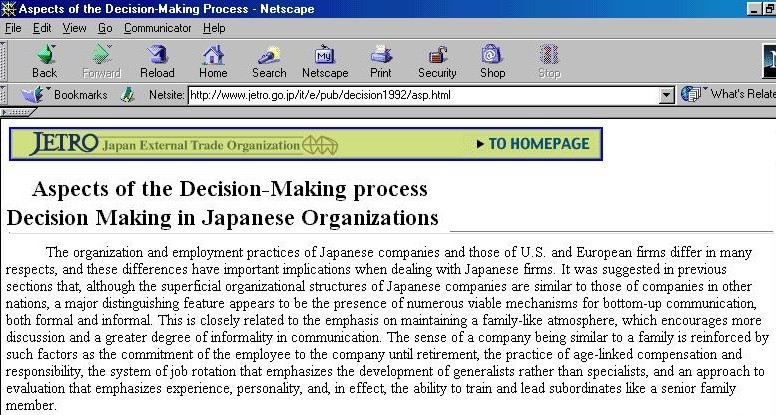 |
BUS 203
Business & Human Resources |
|
|
||
|
||
|
|
Chpt 7

SWOT |
If the measurable Objectives
of an organization can be achieved, then the Goal is accomplished.
|
Chpt 7

SWOT |
Breaking down SWOT
Evaluating an Organization's Strengths
1. Organizational weaknesses--skills and capabilities that do not enable a firm to choose and implement strategies that support its mission.
Some of the information in the SWOT breakdown comes from Prof. Ronald C. Gardner, Howard Community College, Columbia, Maryland, USA http://classweb.howardcc.edu/mamt140/homework2.htm |
Chpt 8
 |
In the text, page 216, "Decision
Making" is defined as
a simple way of expressing this would be simply "picking the best from many" When you talk about a "decision making process", you are going further to consider that fact that
|
Chpt 8

Group Decision Making in Organizations Chpt 8
Chpt 8
Chpt 8
Chpt 8
|
this information on group
decision making can be found on several sites on the web, as well as in
the text,
Some of the written below, come from Prof. Ronald C. Gardner's site http://classweb.howardcc.edu/mamt140/homework2.htm Group Decision Making in Organizations
1 . Interacting groups --most common form of group decision making. It occurs whenever an existing or newly formed group is asked to make a decision. 2. Delphi groups --used for developing a consensus of expert opinion. The Delphi procedure solicits input from a panel of experts who contribute individually. Their opinions are combined and averaged. These results are fed back to the experts and the process continues until a solution is reached. This method can be used to make group decisions when members cannot attend a meeting. It is a method for gathering systematically written judgements from members using a set of sequentially modified questionnaires interspersed with summaries of results from previous rounds of information gathering from members. The technique was developed by the Rand Corporation as a way of forecasting future events of national and international importance . The technique takes considerable time and effort to complete. In using it, members of the group may not know the other group members and it requires a central co-ordinating mechanism to manage the alteration, transmission, and summarisation of questionnaire data. The Delphi technique follows these steps:
"The system for formulating decisions at the lower or middle levels of Japanese companies involves the preparation and circulation of a ringi-sho, or roughly a "project proposal." Under this system, after informal discussion of a proposal, which may involve various levels of management and other employees, an individual or group within a section takes the initiative by writing it up in ringi-sho form. The proposal is then circulated among interested parties, usually accompanied by a verbal explanation by one or more members of middle management. After careful discussion among all the interested parties, various modifications are proposed. When all parties reach a consensus, the appropriate persons affix their seals to the ringi-sho and it is sent to those responsible for making the final decision." 
3. Nominal group
This method structures the work group's creative process to minimise verbal interaction among members. The group, usually no larger than nine, follows a highly structured procedure which is briefly described below:B. Advantages of Group Decision Making - While there are many advantages and disadvantages to group decision making, one main advantage is that more ideas are generated, which should lead to a better solution In Japanese companies in the 1970's and 1980's, the process of "nemawashi" resulted in many of the middle managers being able to contribute to the decision making process - which enabled the process to take place - however the drawback was the great amount of time for this process to take place.C. Disadvantages of Group Decision Making 1. Perhaps the biggest drawback of group decision making is that additional time and resources are required to arrive at a group decision. In the 1980's and 1990's many North American companies were hampered when they tried to adopt group decision making processes. It is hard to schedule meeting times for groups - there is also a lot of paper work involved and memos back and forth - all of which take time. Also, the more people involved in contributing to the decision, the more likely you will have dissenting opinions, which will take time to resolve.2. Group-think, when the group's desire for consensus and cohesiveness overwhelms its desire to reach the best possible decision, can occur when a group is asked to make a decision. One of the curses of political correctness in the late 1990's and early millennium, is the exaggerated concern decision making groups have with their concern for all the possible negative outcomes - which causes them to be so tortured in contemplating these scenarios that they never get around to making a decision at all.D. Managing Group Decision-Making Processes - Managers must be aware of the pros and cons of group decision making. Also, the group should analyze all alternatives critically and allow divergent viewpoints to be presented. It is also a good idea to ask one member to play the role of devil's advocate. An advocate is a word used to describe the process of speaking on behalf of someone. The phrase "Devil's advocate" is used when you have a person speaking on behalf of the opposite position - not because they want to, but because they want to force the other side to deal with challenging issues. In some business situations, we use another term "Red Team". |
| Quiz
June 12th Wednesday class June 13th Thursday class mostly multiple choice covers chapters 1,6,7,8,& 10 |
Chpt 10

Basics of Organizing |
PODC
"organizing is deciding how best to group organizational elements [activities and resources]" job design
or
or
Alternatives to specialization
|
Chpt 10

Basics of Organizing |
Departmentalization
(grouping jobs together)
common bases for departmentalization
(related to departmentalization)
|
Chpt 10

Authority |
Distributing
Authority
|
Chpt 10

Rank |
Line Positions
Staff Positions Administrative Intensity
|